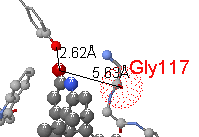
Lac repressor bending the DNA operon. More..
Announcement - One Day Course:
Practical Protein 3D Structure Visualization and Structural Bioinformatics
April 2 (Wednesday), 2008,
Weizmann Institute of Science, Rehovot, Israel
(Israel Structural Proteomics Center and Bioinformatics & Biological Computing)
Room changed due to large number of participants:
Classroom #5, Ruthie and Samy Cohn Building
Laptop computer now required: no computers can be provided in this room.**
9:00 - 17:00. Host: Joel L. Sussman.
taught by Eric Martz
from the University of Massachusetts, Amherst MA USA,
principal author of FirstGlance in Jmol, Protein Explorer, and related resources.
Registration online for this course.
Practical Protein 3D Structure Visualization and Structural Bioinformatics
April 2 (Wednesday), 2008,
Weizmann Institute of Science, Rehovot, Israel
(Israel Structural Proteomics Center and Bioinformatics & Biological Computing)
Room changed due to large number of participants:
Classroom #5, Ruthie and Samy Cohn Building
Laptop computer now required: no computers can be provided in this room.**
9:00 - 17:00. Host: Joel L. Sussman.
taught by Eric Martz
from the University of Massachusetts, Amherst MA USA,
principal author of FirstGlance in Jmol, Protein Explorer, and related resources.
Registration online for this course.

Anti-Alzheimer's drug analog (*) interaction with acetylcholinesterase (Dvir et al./Sussman, 2002).

